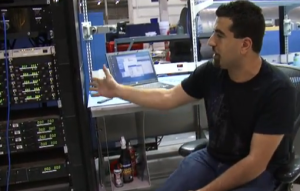The commercial revolution in spaceflight is predicated on bringing computing power and Web 2.0 practices to bear in the quest to reduce the cost of lofting payloads to space. All this must be accomplished while demonstrating safety and reliability for the day when commercial space companies begin carrying crews to Earth’s orbit and beyond.
Among the leaders in this endeavor is Space Exploration Technologies Inc., or SpaceX, the first commercial company to send an unmanned cargo ship to the International Space Station (it is also the only commercial company that can return an orbiting spacecraft and its cargo to Earth).
Much of SpaceX’s success hinges on its ability to leverage high-performance computing along with computer-aided engineering tools in the drive to reduce the cost of lifting a pound of payload to orbit. For the commercial space industry, the Holy Grail for launch cost is about $1,000 per pound to orbit. That goal remains elusive. Still, innovators like SpaceX are making headway by moving away from the traditional “arsenal model” of heavily subsidized NASA contractors to agile enterprises that know how to leverage new computing tools along with agile engineering practices.
The remaining question in the dangerous arena of spaceflight is whether computer simulations can replace the time-tested method of blowing up stuff to find out why it broke. Only then can spacecraft carry humans.
SpaceX founder Elon Musk has embraced the use of new computing tools to develop everything from reusable rockets to floating launch pads. All are designed with the single-minded goal of reducing the cost of commercial space operations while ensuring crew safety. The upstart space company has yet to fully demonstrate that capability, but it has plans in the works to carry crews to the space station later in the decade under a NASA contract awarded in 2014.
In a video tour of the SpaceX facility in Hawthorne, Calif., Musk noted: “Where ever possible we try to design a [rocket] part in 3-D, to manufacture it in 3-D and then to inspect it in 3-D, so we minimize the number of 2-D to 3-D conversions.”
The company also uses full “hardware in the loop” simulations of first and second stage engines for its workhorse Falcon 9 rocket. “From an avionics, electronics standpoint and from a steering standpoint, the flight computer and avionics think they are flying the vehicle to space,” Musk explained. “Then we verify that the computer has done all the things it’s supposed to do make the rocket get successfully to space.”
Standing in front of the SpaceX server room as the company was ramping up for flights to the space station, Musk is seen with about 500 processors used for applications like computational fluid dynamics, finite element analysis and storage for 3-D solid modeling. The server room has certainly grown as the company has begun launching payloads for several international customers. A launch failure can cost billions of dollars, making realistic launch simulations a must.
Those simulations are followed by “live-fire” engine testing a a SpaceX test facility in Texas before rockets and spacecraft are shipped to Cape Canaveral, Florida, or Vandenberg Air Force Base in California for launch.
Along with sheer computing power, another key tool is computational fluid dynamics used to design next-generation rockets and spacecraft. SpaceX has partnered with vendors like Ansys Inc. in an effort to harness computing power in the design and development process.
Commercial space competition is creating “substantial pressure to drive down the cost technology of putting a pound of [payload] into orbit and incredible pressure on cycle time development,” notes Rob Harwood, Ansys industry director for aerospace and defense. “We all know you don’t get a second chance in space, it has to work first time.”
Ansys is the primary computer-aided engineering tool used by SpaceX since the company needs to investigate multiple types of physics when designing rocket engines and spacecraft. For example, engineers need to understand thermal transients on its Dragon spacecraft that result in stresses on the cargo ship.
According to Andy Sadhwani, SpaceX senior propulsion analyst, Ansys is used to shorten the design analysis cycle, increasing the rate of “design evolution” while reducing test costs. The last area, testing, remains controversial within the space industry. Given that space is an unforgiving environment, some critics argue that stresses on spacecraft can’t be simulated. Rather, hardware needs to be pushed to breaking point to ensure that it won’t fail in space.
The SpaceX Merlin 1D engine is powered by kerosene and liquid oxygen. Ansys provides most of the engine analysis and “size” requirements for engine components. The tool is also used to gather “pre-test predictions” on engine strain and thermal behavior. That data is “pulled from our models and favorably anchored to our hot-fire testing in Texas,” said Bulent Altan, SpaceX avionics engineer and systems integrator.

As SpaceX eyes manned flights, it is looking for ways to squeeze more thrust out its Merlin rocket engines. Designers were able to “leverage the link between [computer] models and test data to nail designs on the first or second try,” Sadhwani claimed.
Another issue for metal-bending aerospace companies is easing the inevitable backlog in the machine shop. The ability to use computational fluid dynamics and other simulations tool is being leveraged by SpaceX to reduce the number of test iterations. That in turn has shortened the design analysis cycle so the company can avoid logjams in the machine shop and remain on schedule for its next launch.
Musk’s efforts to transform the way aerospace companies operate have so far worked. What counts in the space business is actually doing what you said you were going to do, as in sending humans to the moon by the end of the 1960s. The big test for SpaceX and the rest commercial space industry will come when humans are strapped into the coaches of a commercially designed and built spacecraft and launched into orbit.




























































